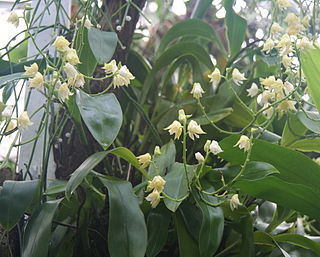
Dioscorea polystachya or Chinese yam, also called cinnamon-vine, is a species of flowering plant in the yam family. It is sometimes called Chinese potato or by its Japanese name nagaimo.

Dioscorea oppositifolia is a type of yam (Dioscorea) native to Myanmar (Burma) and to the Indian Subcontinent.

Manas National Park or Manas Wildlife Sanctuary (Pron:ˈmʌnəs) is a national park, UNESCO Natural World Heritage site, a Project Tiger reserve, an elephant reserve and a biosphere reserve in Assam, India. Located in the Himalayan foothills, it is contiguous with the Royal Manas National Park in Bhutan. The park is known for its rare and endangered endemic wildlife such as the Assam roofed turtle, hispid hare, golden langur and pygmy hog. Manas is famous for its population of the wild water buffalo.

The wildlife of Ghana is composed of its biodiversity of flora and fauna.

Aphanamixis polystachya, the pithraj tree, is a species of tree in the family Meliaceae. It is native to India, Pakistan, Nepal, Bhutan, Bangladesh, Myanmar and Sri Lanka. It is a widely used as a medicinal plant in Ayurveda.
The Sulawesi forest turtle is a critically endangered species of turtle in the family Geoemydidae. The species is monotypic within the genus Leucocephalon. It is endemic to Sulawesi in Indonesia.

Polystachya bicalcarata is a species of plant in the family Orchidaceae. It is found in Cameroon and Equatorial Guinea. Its natural habitats are subtropical or tropical moist lowland forests and subtropical or tropical moist montane forests. It is threatened by habitat loss.

Polystachya, abbreviated Pol in horticultural trade, and commonly known as yellowspike orchid, is a flowering plant genus in the orchid family (Orchidaceae). This rather distinctive genus was described by William Jackson Hooker in 1824 and is the type genus of the subtribe Polystachyinae. It contains about 100 species widespread across many of the tropical areas of the world.
Polystachya cooperi is a species of flowering plant in the orchid family, Orchidaceae. It is native to Cameroon and Nigeria. It grows in forests and woodlands. Most populations are threatened with habitat loss as forests are cleared.
Polystachya farinosa is a species of flowering plant in the orchid family, Orchidaceae. It is native to Cameroon and São Tomé Island. This forest epiphyte has not been collected from Cameroon since 1968 and its population on São Tomé Island is sparse and little known.
Polystachya geniculata is a species of flowering plant in the orchid family, Orchidaceae. It is endemic to Cameroon. It is known from only two locations. It grows in the soil or on rocks.
Polystachya kupensis is a species of plant in the family Orchidaceae. It is endemic to Cameroon. Its natural habitat is subtropical or tropical moist lowland forests. It is threatened by habitat loss.

Polystachya victoriae is a species of plant in the family Orchidaceae. It is found in Cameroon and Gabon. Its natural habitat is subtropical or tropical dry forests. It is threatened by habitat loss.
Prunus polystachya, also called bat laurel, is a species of plant in the family Rosaceae. It is endemic to Singapore.

Areas of forest which grow in KwaZulu-Natal, South Africa mostly on south facing slopes in higher rainfall areas, and along the humid coastal areas. Different types of forest can be identified by their species composition which depends mostly on the altitude, latitude and substrate in which they grow. South facing slopes are favourable for the development of forest as they are more shaded, and therefore cooler and retain more moisture than the northern slopes. The extra moisture on the south slopes is not only favoured by forest trees, but also helps to prevent or subdue wildfires. Fires can also be blocked by cliff faces and rocks or boulders on these slopes, and by streams or rivers at the base of the slopes. The coastal regions are conducive to forest formation, because of high rainfall and humidity which are favoured by forest trees and also help to prevent or subdue fires. The rivers of the coastal areas are also broader than further inland, which may often prevent fires from spreading long distances, and fires generally burn uphill and therefore more often away from areas at low altitude.
Buddleja polystachya is a multi-branched shrub or occasionally small tree endemic to the semi-arid highlands flanking the Red Sea in Eritrea, Ethiopia, Saudi Arabia, Somalia and Yemen, where it grows in secondary scrub or around forest, often along watercourses, at elevations of between 2,200 and 3,600 m ; its range extends southward into the highlands of Kenya and Tanzania. The species was named by Georg Fresenius in the early part of the 19th century.

Grevillea parallela, also known as silver oak, beefwood or white grevillea, is a tree native to northern Australia.

Koenigia polystachya is a species of flowering plant in the knotweed family, known by the common names Himalayan knotweed and cultivated knotweed. It has several regularly used synonyms, including Polygonum polystachyum, Aconogonon polystachyum and Persicaria wallichii.

Moraea polystachya is a species of plant in the family Iridaceae native to southern Africa.












